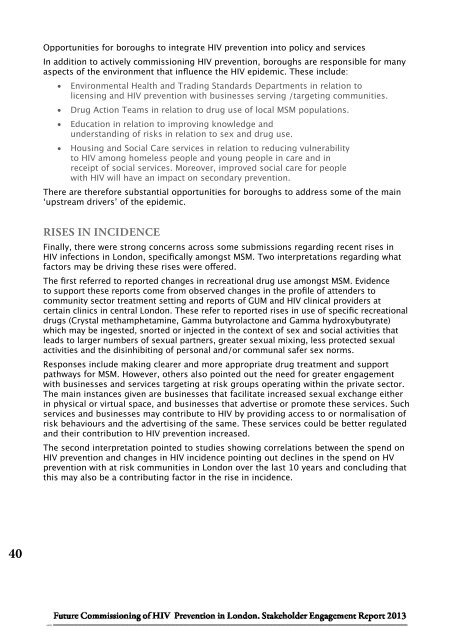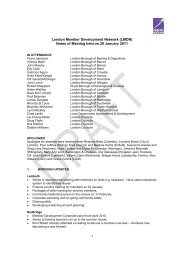Stakeholder Engagement Report - London Councils
Stakeholder Engagement Report - London Councils
Stakeholder Engagement Report - London Councils
You also want an ePaper? Increase the reach of your titles
YUMPU automatically turns print PDFs into web optimized ePapers that Google loves.
Opportunities for boroughs to integrate HIV prevention into policy and services<br />
In addition to actively commissioning HIV prevention, boroughs are responsible for many<br />
aspects of the environment that influence the HIV epidemic. These include:<br />
• Environmental Health and Trading Standards Departments in relation to<br />
licensing and HIV prevention with businesses serving /targeting communities.<br />
• Drug Action Teams in relation to drug use of local MSM populations.<br />
• Education in relation to improving knowledge and<br />
understanding of risks in relation to sex and drug use.<br />
• Housing and Social Care services in relation to reducing vulnerability<br />
to HIV among homeless people and young people in care and in<br />
receipt of social services. Moreover, improved social care for people<br />
with HIV will have an impact on secondary prevention.<br />
There are therefore substantial opportunities for boroughs to address some of the main<br />
‘upstream drivers’ of the epidemic.<br />
Rises in Incidence<br />
Finally, there were strong concerns across some submissions regarding recent rises in<br />
HIV infections in <strong>London</strong>, specifically amongst MSM. Two interpretations regarding what<br />
factors may be driving these rises were offered.<br />
The first referred to reported changes in recreational drug use amongst MSM. Evidence<br />
to support these reports come from observed changes in the profile of attenders to<br />
community sector treatment setting and reports of GUM and HIV clinical providers at<br />
certain clinics in central <strong>London</strong>. These refer to reported rises in use of specific recreational<br />
drugs (Crystal methamphetamine, Gamma butyrolactone and Gamma hydroxybutyrate)<br />
which may be ingested, snorted or injected in the context of sex and social activities that<br />
leads to larger numbers of sexual partners, greater sexual mixing, less protected sexual<br />
activities and the disinhibiting of personal and/or communal safer sex norms.<br />
Responses include making clearer and more appropriate drug treatment and support<br />
pathways for MSM. However, others also pointed out the need for greater engagement<br />
with businesses and services targeting at risk groups operating within the private sector.<br />
The main instances given are businesses that facilitate increased sexual exchange either<br />
in physical or virtual space, and businesses that advertise or promote these services. Such<br />
services and businesses may contribute to HIV by providing access to or normalisation of<br />
risk behaviours and the advertising of the same. These services could be better regulated<br />
and their contribution to HIV prevention increased.<br />
The second interpretation pointed to studies showing correlations between the spend on<br />
HIV prevention and changes in HIV incidence pointing out declines in the spend on HV<br />
prevention with at risk communities in <strong>London</strong> over the last 10 years and concluding that<br />
this may also be a contributing factor in the rise in incidence.<br />
40




